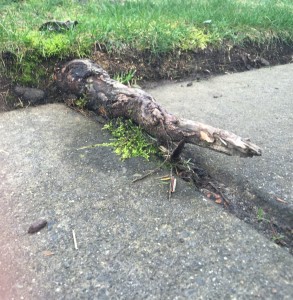This is a photo of my great grandmother, Mildred. I knew her name was Mildred, but to me, she was always Grandma Lulu. It’s confusing sometimes, keeping all the grandparents straight when you’re a little kid. My older sister Shannon came up with a solution: nicknames based on vacation spots.
Thus, in our family we had Grandma (my mom’s mom), Grandma Mexico (aka Margot, Shannon’s dad’s mom), and Grandma Lulu, short for Honolulu. Grandma Lulu not only traveled often to Honolulu, she was born there.
Now, Grandma Lulu was a fascinating character, on which I would elaborate here, if it weren’t for the fact I have decided her life will be the basis for my next novel.
What I can tell you is that while researching Grandma Lulu, I discovered she had a previously unknown 3rd husband. I remember at the time I looked into it initially, it was confusing, because all the evidence pointed to the fact that her 3rd husband had lied about his last name on their marriage license. Grandma Lulu, on the other hand, lied about her place of birth (she said she was born in Oakland, California, not Hawaii), said that it was her 2nd marriage, not her 3rd, and shaved 5 years off her age. The age thing isn’t all that surprising, considering she was marrying a man 11 years her junior.
A couple weeks ago I began receiving messages from a man who is a relative of Mildred’s 4th husband, Jay. Mildred stayed married to Jay until his death, and, as far as I know, never married again, living her remaining fifteen years of life single, but dating. A lot. Her married boyfriend, who showed up at her funeral, handcrafted the wooden spice rack that hangs in my mother’s kitchen to this very day.
Grandma Lulu died when I was 10, so I knew her, but I didn’t know much of her story. She was quiet, and tiny, and she always had froot loops when we came to visit. That was a treat for us, because my mother was a health nut and we always had Wheaties and Cheerios. I knew she liked birds, and she wore Hawaiian mumus, even while living in California. She gave me my first Barbie doll, a ballerina.
As a kid, I wasn’t privy to any of the details of her life, her choices, or her complicated relationship with my grandfather, whom she left behind at 18 months old. I have approached researching her life with curiosity, but enough emotional distance from the pain her choices caused my grandfather to recognize that she had a lot of pain of her own. Her pain likely lead to many of her actions, her multiple marriages, her wanderlust.
Anyway, the man researching Mildred’s life because of his connection to Jay, had lots of questions for me. He was confused by the last name I had attributed to Mildred’s third husband William, which was different from the information on the marriage license. I explained what my research had found, and it spurred us both on to try and figure out why William had not only changed his name from Woodcock to Hubbard, but listed his father’s name differently as well.
And that is how I found myself deeeeep down the rabbit hole of ancestry research.
The name change occurred after William’s father had passed away. He not only used his new name Hubbard when marrying Mildred, he used it on his marriage license to his second wife, Frances.
This is where the story takes an even more interesting turn. William married Frances in 1939. On their marriage license, Frances lists her age as 18, and that this is her first marriage. Initially I was perturbed by the fact that William was 32 at the time of their marriage, but the deeper I dug, the more I realized Frances was no naïve teenager.
In the 1940 census, less than a year after her marriage to William, Frances is back living with her parents. Along with her, is a one year old son, who has a completely different last name, Doiron. Also living at home is her sister, a 19 year old divorcee with a 4 year old son.
That led me to a marriage record for Frances to a man named Melvin Doiron in October of 1938. At the age of seventeen, she married Melvin, and five months later gave birth to Ronald. Four months after Ronald was born, she married William. One must assume that in the nine months between the two marriages, there was a divorce or annulment. (I would hope)
You might ascribe this behavior to youth, however, Frances went on to marry FOUR MORE MEN. That brings us to a total of six husbands. There’s a possible indication of a seventh, but I haven’t been able to definitively prove that.
By 1941, at the age of 19, Frances was on her third husband. Of course, on her marriage license to husband number three, she said it was only her second marriage. Of all her husbands, Frances managed to marry a McQueen, a McKim and a McKibben. I wonder if there’s a strange psychological reason one might be attracted to a certain part of the alphabet.
I find myself pondering what was going through the mind of Frances, why she couldn’t keep a relationship. I can’t imagine she enjoyed all the ups and downs, although I suppose it’s possible. Part of me wants to believe so many marriages indicate a woman who is a hopeless romantic, even if she didn’t have the skills to pick a man.
In 1970, Frances and her 5th husband, Gail, divorced after 8 years of marriage. Seven months later, she married her sixth husband, Charles. That marriage lasted from November through to May of the following year. Less than a year after her divorce, she remarried Gail. Somehow, that gave me hope that Frances found happiness. Unfortunately, they divorced again three and a half years later.
More than what was going through Frances’ mind, I think about her son, Ronald. From everything I can see, he was an only child, the product of a short-lived first marriage between his teenage mother and his 23 year old father, who himself ran off at 15 to join the military. Ronald was on his second stepfather before his third birthday. His mother would go on to bring four additional stepfathers into his life. That’s not a lot of stability, although her third husband was around through his teen years.
As for Frances, I’m not sure she got her happily ever after. When she died in 1989, at the age of only 68, She had outlived all of her ex-husbands. I have been unable to find an obituary for her, nor have I been able to locate her grave. Perhaps her son wasn’t sure what last name to put on her grave marker, so he just had her cremated. If they charge by the letter it might be pretty expensive to create one that says: Here lies Frances Lenora Godfrey Doiron Hubbard (which really should be Woodcock) Fulmer Mcqueen McKim Mckibben McKim (didn’t work the 2nd time either).
For me, these people aren’t just names and dates on a chart. I mentally connect with them, imagine their lives, the era and geographical areas they lived, and I find myself rooting for them to have happy endings. I mourn their losses and cheer their success. The lure of the story takes me places I never imagine when I start looking.
You know you’re down the rabbit hole when you’re looking at the immigration papers of the second wife of your great grandmother’s ex-husband’s second wife’s fifth ex-husband, which is where I currently find myself.
If you would like me to go down YOUR family’s rabbit hole, please contact me at Shoreshfamilyreseach@gmail.com, visit my facebook page Shoresh Family Research, or my website Shoresh Family Research.



